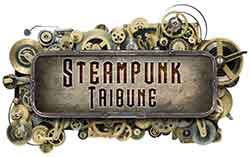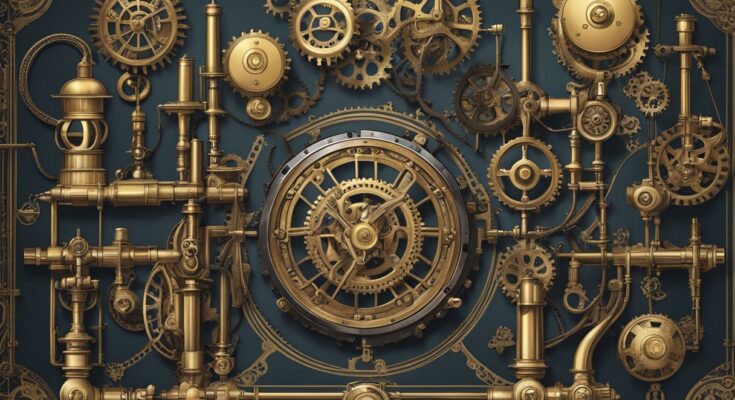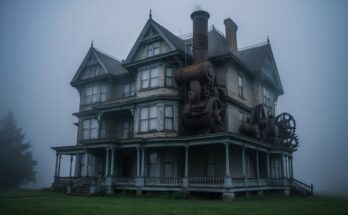Gothic Steampunk is a subgenre of science fiction and fantasy that combines elements of both Gothic and Steampunk aesthetics. It is characterized by its dark and mysterious themes, as well as its use of Victorian-era technology and fashion. The genre has become increasingly popular in recent years, with many fans drawn to its unique blend of historical and futuristic elements.
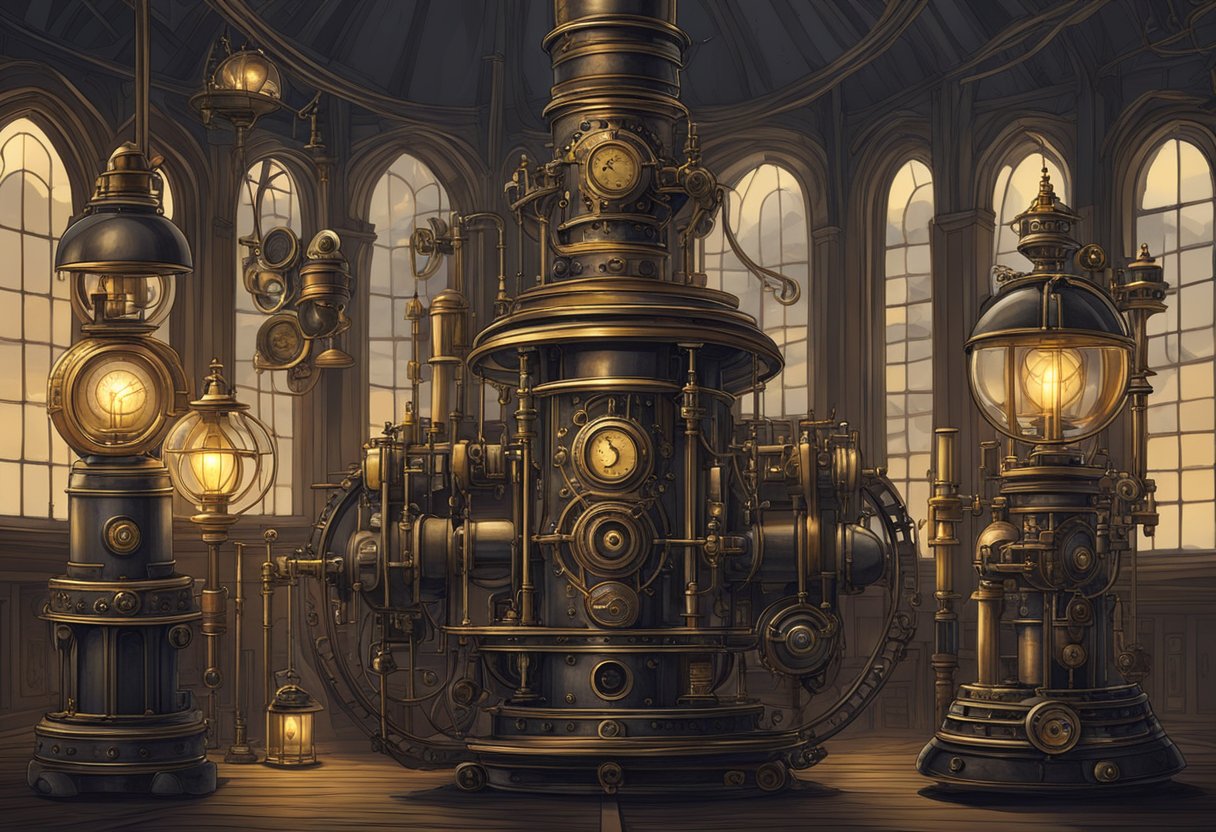
One of the defining features of Gothic Steampunk is its emphasis on the macabre and the supernatural. Many stories in the genre feature ghosts, vampires, and other creatures of the night, as well as themes of death and decay. This dark and haunting atmosphere is often contrasted with the gleaming brass and polished wood of Steampunk technology, creating a unique and compelling visual style.
Another key aspect of Gothic Steampunk is its use of Victorian-era fashion and design. Characters in the genre are often dressed in corsets, top hats, and other period clothing, and the technology they use is often inspired by the inventions of the time. This combination of old and new creates a sense of nostalgia and wonder, as well as a feeling of unease and uncertainty.
Understanding Gothic Steampunk
Gothic Steampunk is a subgenre of Steampunk that blends the aesthetics and themes of Gothic culture with the technology and alternate history of Steampunk. It is a subculture that has gained popularity in recent years and has become a part of the larger Steampunk community.
Gothic Steampunk incorporates elements of Gothic culture such as dark and macabre themes, Victorian architecture, and fashion. It also includes the use of brass, copper, and other metals in the design of Steampunk gadgets and machinery. Gothic Steampunk often features a darker color palette compared to traditional Steampunk, with a focus on blacks, greys, and deep reds.
The subgenre draws inspiration from speculative fiction and alternate history, imagining a world where technology has advanced in a different way than our own history. This allows for a blend of fantasy and science fiction elements in Gothic Steampunk.
In terms of art and aesthetics, Gothic Steampunk is characterized by intricate and ornate designs, often featuring gears, cogs, and other mechanical components. It also incorporates elements of neo-Victorianism, with a focus on Victorian-era fashion and architecture.
Overall, Gothic Steampunk is a unique and fascinating subculture that blends the best of Gothic culture with the technology and alternate history of Steampunk. It is a subgenre that continues to evolve and grow in popularity within the larger Steampunk community.
Historical Context
Gothic Steampunk is a subgenre of science fiction that combines elements of Gothic fiction and Steampunk. To understand the origins of Gothic Steampunk, it is important to look at the historical context in which it emerged.
The Victorian era, which lasted from 1837 to 1901, was a time of great change and innovation. The Industrial Revolution brought about new technologies and advancements in science, which had a profound impact on society. This era saw the rise of steam-powered machinery, which became the driving force behind many industries.
The Edwardian era, which followed the Victorian era, was a time of great social and political change. This period saw the emergence of new technologies, such as the automobile and the airplane, which further transformed society.
Gothic fiction, which emerged in the late 18th century, was characterized by dark, supernatural themes and settings. Gothic literature often featured haunted castles, mysterious supernatural beings, and eerie landscapes.
Steampunk, on the other hand, is a subgenre of science fiction that imagines a world where steam power is still the dominant form of technology. Steampunk often features Victorian-inspired fashion, steam-powered machinery, and retro-futuristic inventions.
Gothic Steampunk combines these two genres, creating a unique aesthetic that blends the dark and eerie themes of Gothic fiction with the retro-futuristic technology of Steampunk. This subgenre often features Victorian-inspired clothing and accessories, as well as steam-powered machinery and gadgets.
In conclusion, the historical context in which Gothic Steampunk emerged was one of great change and innovation. The Victorian and Edwardian eras saw the rise of new technologies and advancements in science, which helped shape the world we live in today. Gothic Steampunk combines elements of Gothic fiction and Steampunk to create a unique aesthetic that celebrates this era of innovation and change.
Literary Influences
Gothic Steampunk is a genre that combines elements of Gothic and Steampunk literature. The genre draws inspiration from various literary works, including those of Jules Verne, H. G. Wells, Mary Shelley, and Bram Stoker.
Jules Verne, a French novelist, is known for his works that explore the possibilities of science and technology. His novels, such as “Journey to the Center of the Earth” and “Twenty Thousand Leagues Under the Sea,” feature characters who use technology to explore the unknown. These works have had a significant influence on the Steampunk genre, which often features steam-powered machines and fantastical inventions.
H. G. Wells, an English writer, is known for his science fiction works, including “The Time Machine” and “The War of the Worlds.” His works often explore the consequences of scientific advancements and the impact they have on society. The themes of science and technology in his works have also influenced the Steampunk genre.
Mary Shelley’s “Frankenstein” is a classic Gothic novel that explores the dangers of playing God and the consequences of scientific experimentation. The novel’s themes of horror and the unknown have had a lasting impact on Gothic literature and have influenced the Gothic elements in the Steampunk genre.
Bram Stoker’s “Dracula” is another classic Gothic novel that has had a significant influence on the Gothic elements in the Steampunk genre. The novel explores themes of horror, the supernatural, and the unknown, which are often present in Gothic Steampunk literature.
Cherie Priest’s “Boneshaker” is a novel that combines elements of Gothic and Steampunk literature. The novel is set in an alternate history where the American Civil War is still ongoing and features steam-powered machines and fantastical inventions. The novel’s blend of Gothic and Steampunk elements has made it a popular example of the Gothic Steampunk genre.
Overall, the literary influences on the Gothic Steampunk genre are diverse and varied. The genre draws inspiration from a range of literary works, including those of Jules Verne, H. G. Wells, Mary Shelley, and Bram Stoker, and continues to evolve as new works are created.
Gothic Steampunk Fashion
Gothic Steampunk fashion is a unique blend of Victorian, Gothic, and industrial styles. It is a sub-genre of Steampunk and Gothic fashion, characterized by its dark and edgy aesthetic. This fashion style is all about mixing vintage and modern elements to create a unique and captivating look.
One of the most iconic pieces of Gothic Steampunk fashion is the corset. Corsets are a key element of this fashion style, providing a structured and fitted silhouette. They are often made of leather or lace and can be worn over or under other clothing items.
In addition to corsets, Gothic Steampunk fashion often features waistcoats, top hats, and goggles. These accessories add to the overall industrial and Victorian aesthetic of the fashion style. The use of leather, metal, and other industrial materials is also common in Gothic Steampunk fashion.
When it comes to clothing items, Gothic Steampunk fashion features a mix of Victorian-inspired dresses and modern punk styles. The dresses often feature high collars, lace detailing, and long skirts. Meanwhile, the punk-inspired clothing items are often made of dark denim or leather and feature studs, zippers, and other edgy details.
Overall, Gothic Steampunk fashion is a unique and captivating style that combines elements of Victorian, Gothic, and punk fashion. Its use of corsets, waistcoats, and other industrial-inspired accessories make it a truly unique fashion style.
Key Elements and Aesthetics
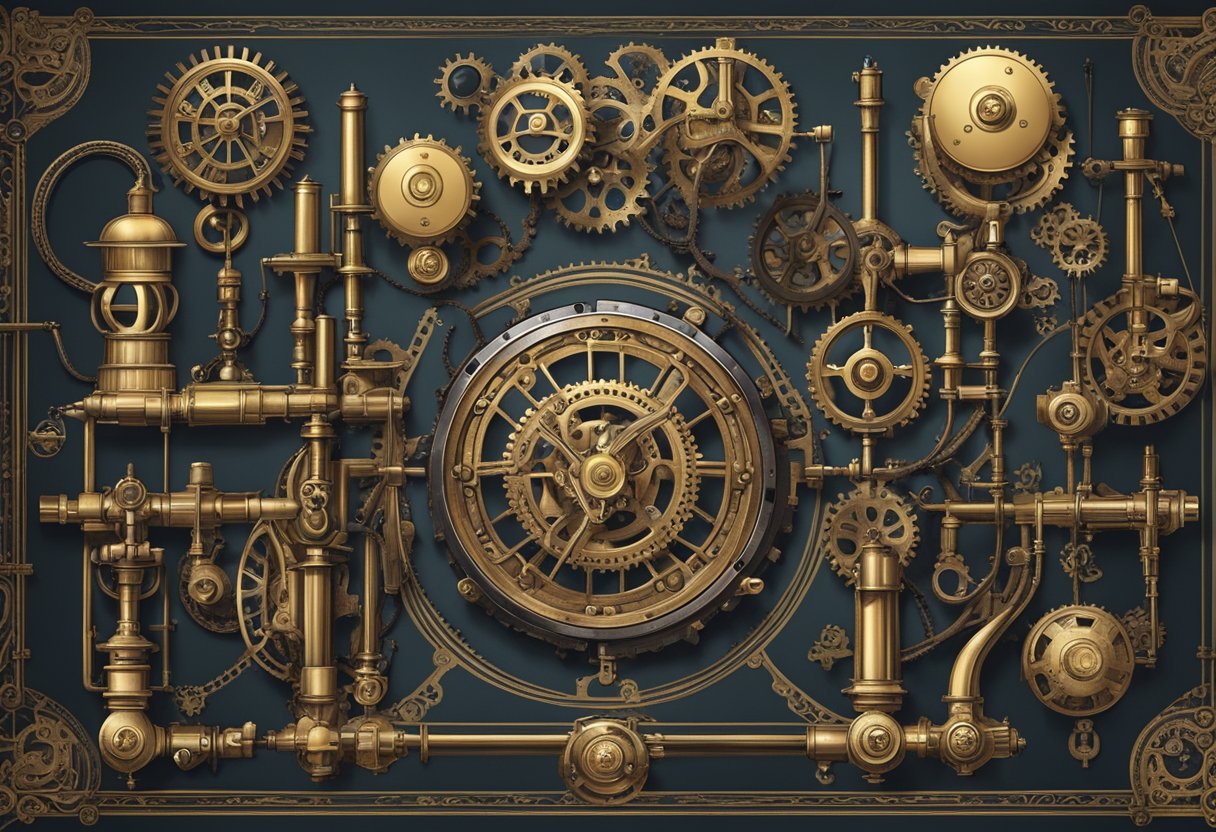
Gothic steampunk is a sub-genre of steampunk that blends elements of gothic horror with the industrial aesthetic of the Victorian era. This unique combination creates a dark and ominous atmosphere that is both eerie and captivating.
The key elements of gothic steampunk include the use of technology and machinery, often incorporating science fiction elements such as clockwork, gears, and cogs. The aesthetic is industrial, with a focus on copper and steel, and often includes mechanical and steam-powered machines.
The clockpunk and teslapunk sub-genres are also closely related to gothic steampunk. Clockpunk focuses on clockwork technology and the use of gears and cogs, while teslapunk incorporates the work of Nikola Tesla and his inventions.
In terms of aesthetics, gothic steampunk is characterized by its dark and moody atmosphere. The use of black, grey, and brown tones, along with brass and copper accents, creates a sense of foreboding and mystery. The incorporation of gothic elements such as skulls, bats, and spiders adds to the eerie feel of the genre.
Overall, gothic steampunk is a fascinating sub-genre that combines the best of both gothic horror and steampunk. Its unique blend of technology, science fiction, and industrial aesthetics creates a world that is both intriguing and captivating.
Music and Artistic Expression
Gothic steampunk is not just a fashion style but also a subculture that has its own music and artistic expression. The music of gothic steampunk is a fusion of different genres such as dark cabaret, industrial, and folk rock. It is characterized by haunting melodies, dark lyrics, and a mix of electronic and acoustic instruments.
One of the most popular bands in the gothic steampunk scene is Abney Park. Their music is a blend of industrial, world, and rock music with a steampunk twist. Their songs are often inspired by Victorian literature and themes of adventure, exploration, and rebellion.
Another band that is popular in the gothic steampunk scene is The Men That Will Not Be Blamed For Nothing. Their music is a mix of punk rock and Victorian music hall, with lyrics that explore the darker side of Victorian life. They often sing about the working-class struggles and the harsh realities of life in the 19th century.
Unwoman is a solo artist who also has a strong presence in the gothic steampunk scene. She is known for her haunting vocals and her use of the cello in her music. Her songs often deal with themes of love, loss, and the struggles of being a woman in a male-dominated society.
In addition to music, gothic steampunk also has its own artistic expression. This can be seen in the fashion, literature, and visual arts of the subculture. Gothic steampunk fashion often incorporates elements of Victorian fashion such as corsets, top hats, and waistcoats, but with a darker twist.
In literature, gothic steampunk often explores themes of science fiction, fantasy, and horror, with a Victorian-era aesthetic. Visual arts in the gothic steampunk scene often incorporate elements of Victoriana, such as clockwork, gears, and steam-powered machinery.
Overall, gothic steampunk is a subculture that values creativity, individuality, and artistic expression. Its music and artistic expression are a reflection of these values and are an important part of the subculture’s identity.
Gothic Steampunk in Media and Entertainment
Gothic Steampunk has made its way into various forms of media and entertainment, including films, anime, and mainstream culture. One of the most notable examples of Gothic Steampunk in film is “Wild Wild West” (1999), directed by Barry Sonnenfeld and starring Will Smith and Kevin Kline. The film features an alternate history where steam-powered technology is prevalent, and the main antagonist is a mad scientist who creates advanced weapons.
Another popular example of Gothic Steampunk in media is the anime series “Fullmetal Alchemist” (2003-2004), which takes place in a world where alchemy is the primary form of science and technology. The series features a mixture of Gothic and Victorian aesthetics, with characters sporting top hats, waistcoats, and other period clothing.
Gothic Steampunk has also been incorporated into mainstream culture through various forms of media, such as music and fashion. The band “The Men That Will Not Be Blamed For Nothing” is known for their Gothic Steampunk-inspired music, which often features lyrics about Victorian-era themes and steam-powered technology.
In addition, the comic book series “The League of Extraordinary Gentlemen” (1999-2019) by Alan Moore and Kevin O’Neill features a team of Victorian-era literary characters who band together to fight evil. The series incorporates elements of Gothic Steampunk, including advanced technology and supernatural creatures.
Overall, Gothic Steampunk has become a popular aesthetic in media and entertainment, appealing to fans of both Gothic and Steampunk genres. Its unique blend of Victorian-era aesthetics and steam-powered technology has captured the imaginations of many, and it continues to inspire new works in various forms of media.
Gothic Steampunk Subculture
Gothic Steampunk is a subculture that combines elements of the Gothic and Steampunk cultures. The Gothic subculture is known for its dark fashion, music, and literature, while the Steampunk culture is characterized by its Victorian-inspired fashion and technology. The combination of these two cultures creates a unique aesthetic that is both dark and elegant.
Gothic Steampunk enthusiasts often incorporate elements of both cultures into their fashion and lifestyle. They may wear corsets, top hats, and goggles, as well as black leather and lace. The color palette is often dark, with black, brown, and deep reds being popular choices.
The Gothic Steampunk subculture is a diverse community that welcomes people of all backgrounds and identities. While some may associate the subculture with a particular type of person, such as goths or steampunk enthusiasts, it is important to remember that there is no one “right” way to be a part of the Gothic Steampunk community.
In conclusion, the Gothic Steampunk subculture is a unique blend of two distinct cultures that creates a dark and elegant aesthetic. It is a diverse community that welcomes people of all backgrounds and identities.
Related Genres and Subgenres
Gothic Steampunk is a subgenre of both Gothic and Steampunk genres, but it also shares some similarities with other related genres and subgenres. Here are some of the most relevant ones:
Dieselpunk
Dieselpunk is a genre that is often lumped together with Steampunk due to their shared interest in retro-futuristic technology and aesthetics. However, while Steampunk focuses on the Victorian era and steam-powered machinery, Dieselpunk is set in the interwar period and features diesel-powered technology. Dieselpunk also tends to have a more gritty and industrial feel than Steampunk, which is often more romantic and ornate.
Steamgoth
Steamgoth is a subgenre of Steampunk that emphasizes the Gothic elements of the genre. Like Gothic Steampunk, Steamgoth often features dark and moody settings, supernatural creatures, and a general sense of foreboding. However, Steamgoth tends to be more focused on the Steampunk aesthetic, with a greater emphasis on gears, clockwork, and other mechanical elements.
Retrofuturism
Retrofuturism is a genre that imagines what the future might have looked like from the perspective of the past. It often involves a mix of outdated technology and futuristic elements, creating a unique blend of nostalgia and speculation. Gothic Steampunk could be seen as a form of retrofuturism, as it combines the Victorian era with futuristic technology and magic.
Magic and Alchemy
Magic and alchemy are often integral parts of Gothic Steampunk stories, adding an extra layer of mystery and intrigue. While Steampunk tends to focus on science and technology, Gothic Steampunk often incorporates supernatural elements such as ghosts, witches, and demons. Alchemy, the ancient practice of turning base metals into gold, is also a common theme in Gothic Steampunk, as it represents the quest for ultimate power and knowledge.
Monsters
Monsters, both real and imagined, are a staple of Gothic literature and are often present in Gothic Steampunk stories as well. From vampires and werewolves to giant robots and Lovecraftian horrors, Gothic Steampunk offers a wide range of terrifying creatures to explore. These monsters often represent the darker aspects of human nature, such as fear, desire, and madness.
Influence of Gothic Steampunk
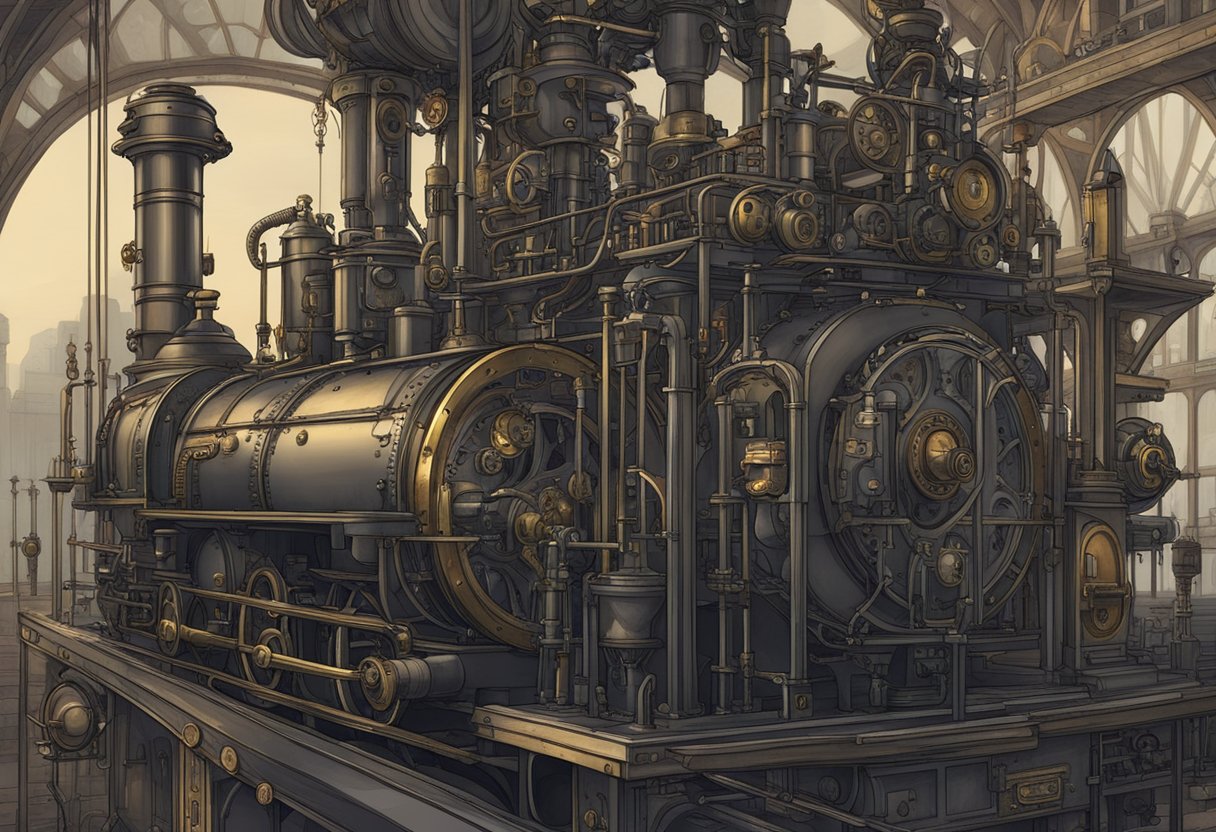
Gothic Steampunk has been heavily influenced by various creative and futuristic elements, which have contributed to its unique style and aesthetic. Some of the key influences of Gothic Steampunk are discussed below:
Victorian Era
The Victorian era, which spanned from 1837 to 1901, has had a significant impact on Gothic Steampunk. This period was marked by a fascination with machinery and technology, which is reflected in the intricate and ornate designs of Gothic Steampunk. The Victorian era also saw the rise of Gothic literature, which has influenced the dark and mysterious themes of Gothic Steampunk.
Industrial Revolution
The Industrial Revolution, which began in the late 18th century, brought about a significant shift in manufacturing and production. This period saw the development of new technologies, such as steam power and mechanization, which have been incorporated into the aesthetic of Gothic Steampunk. The Industrial Revolution also had a significant impact on the social and economic structures of society, which is reflected in the themes of class struggle and social inequality in Gothic Steampunk.
Science Fiction
Science fiction has been a significant influence on Gothic Steampunk. The genre has contributed to the futuristic and imaginative elements of Gothic Steampunk, which often incorporate advanced technologies and alternate realities. Science fiction has also influenced the themes of exploration and discovery in Gothic Steampunk.
Gothic Horror
Gothic horror has played a significant role in the development of Gothic Steampunk. The genre has influenced the dark and macabre themes of Gothic Steampunk, which often incorporate supernatural elements and horror tropes. Gothic horror has also influenced the use of dark and moody aesthetics in Gothic Steampunk.
In summary, Gothic Steampunk has been influenced by a range of creative and futuristic elements, including the Victorian era, the Industrial Revolution, science fiction, and Gothic horror. These influences have contributed to the unique style and aesthetic of Gothic Steampunk, which is characterized by intricate designs, dark themes, and futuristic technologies.
